|

by Richard C. Hoagland
2004
from
EnterpriseMission Website
Part 1
It was one of those sunny, Southern California days that songwriters
have made famous.
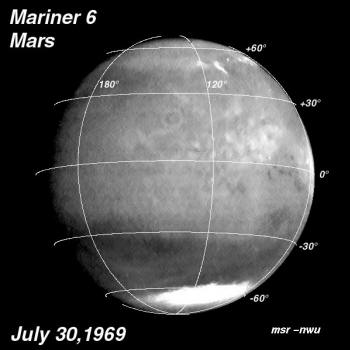
The group of us gathered at NASA’s Jet Propulsion Laboratory that
morning, just north of Los Angeles, in Pasadena, were still slightly
in a daze; just a week or so before, this same diverse assembly –
veterans of America’s fledgling space program ranging from space
scientists to space journalists, from network anchors to their
production staffs and advisors – had been uniquely privileged to
witness firsthand the modern culmination of a Dream:
Neil Armstrong’s first immortal footprints on the Moon.
Now, seemingly but an eye blink later, this same diverse group was
gathering for an equally unprecedented encore … the flyby of an even
farther planet by twin unmanned NASA spacecraft:
Mariners 6 and 7.
The destination this time?
Mars.
This was not the first visit by an American spacecraft to the
mysterious Red Planet. That honor was reserved for a previous
unmanned mission – Mariner 4 – which flew only 6000 miles away in
July of 1965. But now, only four years later – literally, as Neil
and Buzz were being simultaneously debriefed in their quarantine in
Houston from their extraordinary human adventures on the Moon just
days before – those of us covering the on-going NASA program were
anticipating the impending reconnaissance of the next “obvious
destination” for human beings beyond the surface of the Moon (as
viewed from the unbelievable perspective of “the Summer of 1969”)—
Mars itself.
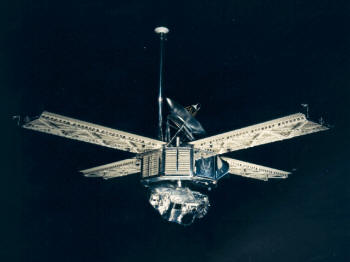
Now just days away from Mars this late July, the two new unmanned
spacecraft (above) were far more sophisticated than the pioneering
Mariner 4; instead of a single television camera as the major
“science instrument,” Mariner 6 & 7 carried dual television systems
(for narrow and wide-angle imaging) – including, a capability for
the first close-up color images of Mars; in addition, as opposed to
the set of interplanetary “particle and field” experiments carried
by Mariner 4, these spacecraft focused solely on an array of
sophisticated additional instrumentation for the first detailed
close-up spectral analysis of Mars atmosphere and surface.
These “ultraviolet and infrared spectrometers” -- capable of
detecting extremely low concentrations of a range of atmospheric
gases – were co-mounted with the cameras on a movable “scan
platform,” which hung below the main body of the spacecraft (above).
It was through searching for key “biomarkers” in the Martian
atmosphere, gases that on Earth are created by living organisms,
that the NASA scientists hoped to find out if Mars might be “alive.”
In particular, the Mariner instruments were searching for two key
hydrogen compounds -- methane and ammonia -- known to be given off
by living systems ….
The twin Mars exploration spacecraft – Mariners 6 and 7 – were
launched just a month apart, in February, and again in March, of
1969. They arrived at Mars just four months later; Mariner 6 flying
within ~2000 miles of Mars’s surface on July 30th, Mariner 7,
following at about the same distance, passing Closest Approach on
August 4th.
Unfortunately, during the July 30th flyby, critical refrigeration of
the Mariner 6 infrared spectrometer (IRS) malfunctioned – thus
preventing the recording of long-wave spectral information. This
meant that, if we were going to discover any “biomarkers” indicative
of living organisms currently on Mars, we would have to await
Mariner 7’s imminent encounter … fortunately, only four days later.
I will always remember that packed JPL Auditorium, 48 hours after
Mariner 7 successfully flew by the planet Mars. Its IRS instrument
had worked perfectly, but it had taken almost two additional days
for the Berkeley science team (whose experiment it was) to fly to
and from Berkeley to reduce their preliminary spectra. Now, they
were back at JPL … about to tell us what they’d found.
First up, however, was a display of the spectacular fly-by Mariner 7
images (below). The classic, enigmatic dark markings had never been
this clear; the rotation of the planet so easily discerned -- as the
distances, image resolution, and early questions raised by
never-before-seen details were patiently explained by the Imaging
Team Leader and his colleagues.
Soon – for those of us waiting impatiently for the crucial
spectrometer results – the picture show was over. Now, another side
of history was about to begin ….
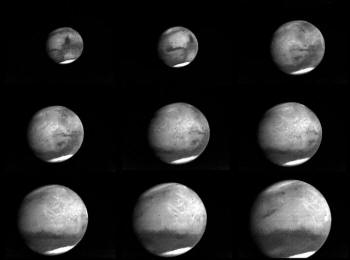
As Science Advisor for the Special Events Unit of CBS News, I was
standing at the back of Von Karman this particular morning, beside
veteran CBS reporter Bill Stout, both of us taking in the scene. My
job: interpret the technical jargon coming from the NASA panel that
Stout didn't understand … which left me with a lot of time to
examine the new images and observe the reactions in the room; for
I’d quickly learned that Bill Stout – whom I’d met for the first
time just weeks before, for our historic coverage of Apollo 11’s
landing on the Moon -- knew almost everything about the space
program … if not this new Mars mission. Luckily – because of this --
I was free to truly focus on what was going on … and what it felt
like to be a witness to space history.
As with everybody else gathered in Von Karman on that morning,
though mightily impressed by the new images – which showed Mars with
a clarity no human eyes had ever seen before (Lowell included …) –
Bill and I ... and a thousand other folks .... were impatiently
awaiting the BIG show … the one Mariner scientist guaranteed to make
the CBS Evening News that night (after we sent our story to New
York), regardless of his results: George Pimentel.
Dr. Pimental was the literal creator and Principal Investigator
(chief scientist) for the Mariner 6& 7 Infrared Spectrometers (IRS,
below). As each Mariner flew by the planet at about 2000 miles, the
infrared spectra recorded by the spacecraft were supposed to tell
his team (and us!) if the Martian atmosphere did indeed contain any
of the key “biomarkers” just discussed … potential signatures for a
“living, breathing Mars.” This (below) is the remarkable instrument
that Pimental and his Berkeley Team devised.
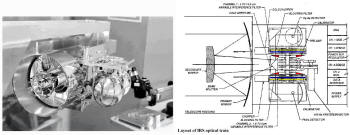
Several years earlier, an obscure, visiting JPL medical technology
specialist,
James Lovelock – who would later gain world wide
recognition as author of the then highly controversial “Gaia
Hypothesis” – wrote a letter to Nature, the preeminent British
science journal. In it
Lovelock recommended:
“… some physical tests for the presence of planetary life. One of
these was a top down view of the whole planet instead of a local
search at the site of landing. The test was simply to analyze the
chemical composition of the planet's atmosphere. If the planet were
lifeless then it would be expected to have an atmosphere determined
by physics and chemistry alone and be close to the chemical
equilibrium state. But if the planet bore life, organisms at the
surface would be obliged to use the atmosphere as a source of raw
materials and as a depository for wastes.
Such a use of the
atmosphere would change its chemical composition. It would depart
from equilibrium in a way that would show the presence of life. Dian
Hitchcock joined me then and together we examined atmospheric
evidence from the infra-red astronomy of Mars (Hitchcock and
Lovelock 1967). We compared this [ground-based, telescopic] evidence
with that available about the sources and sinks of the gases in the
atmosphere of the one planet we knew bore life, Earth.
We found an
astonishing difference between the two atmospheres. Mars was close
to chemical equilibrium and dominated by carbon dioxide, but the
Earth was in a state of deep chemical disequilibrium. In our
atmosphere carbon dioxide is a mere trace gas. The coexistence of
abundant oxygen with methane and other reactive gases, are
conditions that would be impossible on a lifeless planet. Even the
abundant nitrogen and water are difficult to explain by
geochemistry.
No such anomalies are present in the atmospheres of
Mars or Venus, and their existence in the Earth's atmosphere signals
the presence of living organisms at the surface. Sadly, we concluded
that Mars is lifeless now, although it may once have had life….”
Lovelock’s pessimism notwithstanding - obviously based on the
technological limitations to finding those key biological
indicators, methane, ammonia, etc. in the Martian atmosphere up to
that time from Earth - his revolutionary “biomarker” ideas were
actually at the heart of Pimental’s Mariner ‘69 experiment. For,
Pimental’s spacecraft-based, infrared detectors were now thousands
of times closer to Mars … and thus potentially millions of times
more sensitive than the best Earth-based telescopic IR observations.
If these tell-tale “biomarkers” were present in the Martian
atmosphere – even in significantly lower concentrations than on
Earth -- this new NASA Mission had the best chance in history of
detecting this evidence of living “Martians” ….
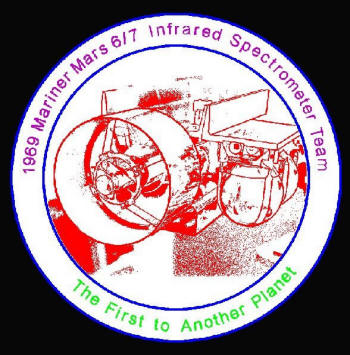
Pimental began to speak, and a classic hush fell over the crowded
Auditorium. One way or another, we were about to know. He called for
his first slide ….
On the giant projection screen that spanned the whole width of Von
Karman, a montage of new close-in Mariner 7 images appeared (below).
Using this mosaic, Pimental explained the geometry of the
simultaneous IRS spectral observations – a swath that took the
instrument’s field of view down across the southern Martian
latitudes … then across the Pole.
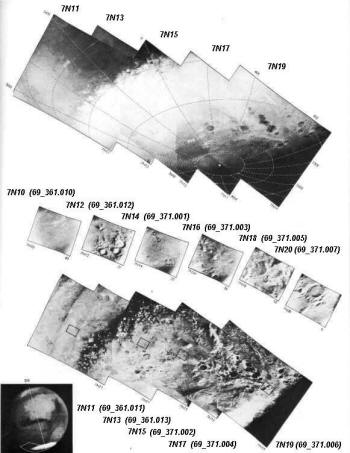
A new graphic appeared (below) -- a squiggly line … depicting
Mariner’s read-out of the Martian atmosphere during this imaging
sequence. The IRS Principal Investigator carefully explained that,
as the instrument crossed the darkened band hugging the edges of the
bright white polar cap of solid CO2 (above), two anticipated
absorptions suddenly appeared – at 3.0 and 3.3 microns (below).

Quoting from a recent history of
Pimental’s Experiment:
“[The] spectra … crossed the south polar cap edge and then continued
deep into the polar cap. IRS spectra from the cap edge showed bands
at 2.0, 3.0 and 3.3 µm (4900, 3300 and 3020 cm -1 ). They [the IRS
Team] knew CO2 ice had a band at 2.0 µm, and this band appeared in
all their polar cap spectra, indicating IRS measured CO2 ice the
entire time it viewed the cap. However, when moving from the cap
edge toward the cap center, both the 3.0 and 3.3 µm bands
disappeared. If CO2 ice caused these two bands, then it somehow
caused them at the cap edge but not farther into the cap.
“To further complicate the issue, the IRS group could not find any
reports in the literature of bands in CO2 ice at 3.0 and 3.3 µm.
Therefore, the disappearance of those two bands while IRS still
viewed CO2 ice, combined with the lack of reports of CO2 ice bands
at those wavelengths led the group to conclude that something which
occurred only at the polar cap edge caused the two bands [Pimentel corr., 18 Jul 1972 ].
“To investigate the puzzle in the few hours before the upcoming the
Mariner 7 press conference, they spent the night measuring spectra.
They were not yet set up to measure sprayed-on CO2 ice in the lab, and so they measured it as a solid block. When they did this,
they found no bands at 3.0 and 3.3 µm. On the other hand, their
[laboratory] spectra of methane and ammonia gas showed bands at 3.0
and 3.3 µm. Therefore, less than 48 hours after receiving their
data, they reported at the Mariner 7 press conference that IRS had
measured methane and ammonia at the polar cap edge [Mar. 7 Press
Conf. Transcript, 1969]. This created quite a stir because of its
implications for life ….”
It was Percival Lowell, the famous 19th Century astronomer --
literal founder of the modern science of “comparative planetology”
-- who made the first detailed observations of this mysterious
“transition zone” around the annually melting Martian polar caps.
Although Lowell believed, based on the technology of the time and
analogy with Earth, that these caps were water ice (we now know – in
large part because of Mariners 6 & 7 -- that they’re frozen CO2),
other aspects of Lowell’s late 1800’s observations were remarkably
accurate – judging by the results of thousands of professional and
amateur astronomers’ recent electronic Mars imaging, made during the
opposition and closest approach of 2003 (below). (These images are
reversed -- with the south Martian polar icecap at the top – as seen
in a normal telescopic view.)
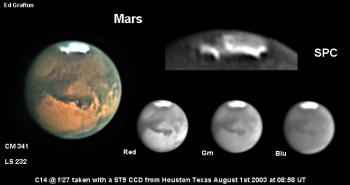
As important as his pioneering Mars work would become, Lowell left
an even more valuable contribution to this fledgling science of planetology: he made his observations (and that of his colleagues at
the Lowell Observatory -- which he founded at Flagstaff, Arizona in
the late 1800’s), available to a world wide, general audience. From
this, we now have an invaluable public record of the earliest years
of planetary science … to compare with modern observations, such as
the Mariner ’69 fly-bys … or last years’ closest approach in over
60,000 years.
Writing in
his first book in 1895, “MARS,”
Lowell observed:
“On May 1, then, Martian time, the cap was already in rapid process
of melting; and the speed with which it proceeded to dwindle showed
that hundreds of square miles of it were disappearing daily. As it
melted, a dark band appeared surrounding it on all sides [above].
Except, as I have since learned, at Arequipa, this band has never,
I believe, been distinctively noted or commented on before, which is
singular, considering how conspicuous it was at Flagstaff . It is
specially remarkable that it should never have been remarked upon
elsewhere, in that a similar one girdling the north polar cap was
seen by Beer and Madler as far back as for it is, as we shall
shortly see, a most significant phenomenon.
In the first place, it
was the darkest marking upon the disk, and was of a blue color. It
was of different widths at different longitudes, and was especially
pronounced in tint where it was widest, notably in two spots where
it expanded into great bays, one in longitude 270 degrees and one in
longitude 330 degrees. The former of these was very striking for its
color, a deep blue, like some other-world grotto of Capri . The band
was bounded on the north, that is, on the side toward the equator,
by the bluish-green areas of the disk. It was contrasted with those
both in tone and tint. It was both darker and more blue ….
“What can explain so general and so consecutive a change in hue?
Water suggests itself; for a vast transference of water from the
pole to the equator might account for it. But there are facts
connected with the change which seem irreconcilable with the idea of
water. In the first place, Professor W. H. Pickering found that the
light from the great blue-green areas showed no trace of
polarization. This tended to strengthen a theory put forth by him
some years ago, that the greater part of the blue-green areas are
not water, but something which at such a distance would also look
blue-green, namely, vegetation. Observations at Flagstaff not only
confirm this, but limit the water areas still further; in fact,
practically do away with them entirely ….”
Lowell’s observations conditioned later generations of astronomers
and readers to anticipate that the “dark band” observed around the
shrinking polar cap each Martian spring was likely melting water,
which was vital (on the arid planet) to supporting some kind of
seasonal vegetation.
As Mariner 7’s IRS instrument swept across this dark transition to
the icy polar cap, the sudden appearance of spectral features
indicative of well-known byproducts of decomposing vegetation, or
colonies of certain microorganisms, seemed to clinch it:
Mariner 7’s remarkable infrared observations, through detection of
one of Lovelock’s crucial “biomarkers,” had all-but-confirmed
current life on Mars ….
That summer night in 1969, while Walter Cronkite summarized our
breaking “possible life on Mars” story from New York, Bill and I
watched the west coast network feed – once again from the back of
JPL’s Von Karman. As the piece ended, I turned and couldn’t help
observing with a wry smile:
“Well, look at that – ‘life on Mars’ ... and we got all of 15
seconds on the Evening News. I wonder what we’d get if they invaded
…?”
A few weeks after his remarkable, historical announcement … George
Pimental had a sudden “change of heart.”
At a specially-called
press conference at NASA Headquarters, in
Washington DC, Pimental publicly retracted his previous assertion
that Mariner 7 “had discovered methane and ammonia on Mars,”
explaining instead that the anomalous lines were more likely due to
“CO2 ice when it has lattice imperfections" [Herr and Pimentel,
1969]. The date of Pimental’s retraction?
September 11, 1969 .
Fast forward the film ….
… to, September 2003.
Dr Michael Mumma, of the Center for Astrobiology at NASA’s Goddard
Space Flight Center, announces -- at the annual meeting of the
Division for Planetary Sciences -- the
preliminary results of a new,
far more sensitive Earth-based search for methane in the atmosphere
of Mars. Utilizing NASA’s Infrared Telescope Facility in Hawaii
(below, left), and the “Gemini South” Telescope in Chile (below,
right), Mumma and his team carried out a detailed new infrared
survey of the Red Planet early in 2003 … with remarkable result.

Mumma’s preliminary analysis (below) reveals a methane concentration
of about 10.5 parts per billion. Under current Martian temperatures
and pressures, this translates to about 90,000 tons ….
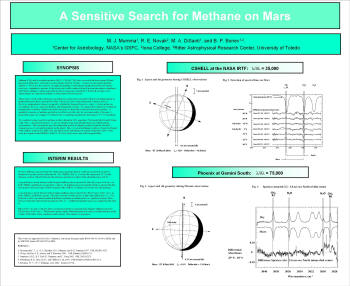
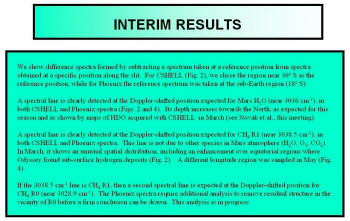
More intriguing -- unlike Pimental’s Mariner ’69 polar observations,
the methane in the current NASA study seems to be concentrated in
the equatorial regions of the planet (above) -- the enhanced
methane, according to Mumma, being greatest over
the two equatorial
locations of “anomalous hydrogen” previously localized by the
Mars
Odyssey GRS experiment (below) –
Precisely the locations of our two projected “ancient tidal oceans”
… and (coincidentally?) the sites of the current rover missions.
Where one of them has just uncovered robust “ground truth” of a
former “ancient salty sea ….”

A few months later, a second team -- this one headed by Vittorio
Formisano, of the Institute of Physics and Interplanetary Science in
Rome – announced their independent discovery of Martian methane. The
new detection was made by the Planetary Fourier Spectrometer (PFS),
aboard ESA’s Mars Express spacecraft.
According to Formisano, the results were obtained by averaging over
1700 atmospheric scans, made of the planet between January and
February, 2004.
Then, a few days later, a third team reported
its separate discovery
of methane on Mars as well – this time led by Vladimir Krasnopolsky,
of the Catholic University of America in Washington DC .
Krasnopolsky and his team used the Canada-France-Hawaii 3.6 meter
telescope (below, right) to accomplish their detection … again, at
about 10.5 parts per billion. The Krasnopolsky team will formally
present their results at the European Geophysical Union's meeting in
Nice, France, in late April.

Three independent teams … three independent results … all affirming
the presence of methane in the current atmosphere of Mars.
So ... what does it mean?
Methane normally has a very limited lifetime, exposed in an
atmosphere such as Earth’s or Mars’ – only a few hundred years at
best – before it is destroyed from various chemical reactions. Thus,
if three teams are detecting methane now on Mars, somehow that means
(at the very least) that the methane is being replaced as fast as it
is disappearing.
Production mechanisms for methane on Earth (or Mars) are limited,
there being essentially only three known sources:
1) volcanic
emissions,
2) certain geochemical reactions, and …
3) biological
activity.
On Earth, essentially all the methane present in the atmosphere
comes from living organisms – either as direct emission by certain
species of bacteria (even in the guts of cows!), or as fermentation
by bacteria of previously living planet life after it has died. This
applies – and is critically important -- even to that methane
released through “geological activity,” including volcanism.
As Prof Colin Pillinger, the Open University space scientist behind
England ’s Beagle 2 Mars lander explained it:
"This may not say that there's life
on Mars, but it doesn't half get close. Whether it is produced
by organisms now or from volcanic activity, the primary source
of methane is microbes. Most of the natural methane gas
released during geological activity on the Earth [volcanism]
originally comes from the decomposition of organic matter. On a
planet like Mars, methane doesn't hang around so you have to
find a way of constantly replenishing it. It is very difficult
to produce except from a biological source …"
It is therefore quite probable, based on this terrestrial geological
analogy, that the three independent teams’ new methane discovery has
one root cause – either present (or past) biological activity on
Mars … or both.
Part 2
This is HUGE ….
In the wake of these startling announcements, wide-ranging
discussions have erupted across the Internet concerning the source
of this new methane. Probably the most authoritative and fact-based
of these is currently taking place on a “weblog” known by the
whimsical title, “Mainly Martian.”
Another cogent analysis is voiced
by “the Mars Society’s” Bob Zubrin. As one would expect, viewpoints
on this surprising development differ vociferously – mainly, as to
whether the new methane measurements are “geological” or
“biological.”
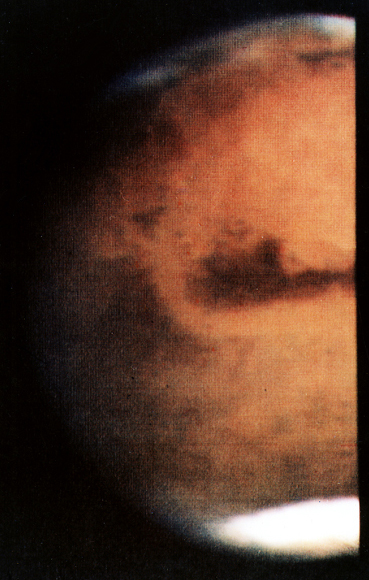
Mariner 7: First Color Far Encounter Mars Image
Fortunately, the scientific test for “biological methane” in this
case is elemental: careful measurement of the ratio of carbon
isotopes bound with hydrogen, in the methane molecules detected in
the Martian atmosphere.
For a variety of reasons, biologically “fixed” carbon has a
preference for the lighter isotope – Carbon 12 – over the heavier
version also found in nature, Carbon 13. Methane produced by
non-biologically processes – such as volcanically heated rocks
acting on water vapor and carbon dioxide – does not show any such
preferences for Carbon 12. Thus, measurement of this key isotopic
ratio in the Mars methane will compelling establish its true origin. Pilinger’s Beagle 2 carried precisely the instrumentation needed to
determine the carbon isotope ratios of any methane in the Martian
atmosphere. Unfortunately (coincidentally?) -
Beagle 2 was lost on entry … and other, similar spacecraft
observations are probably
years away ….
Curiously, in all of these on-going discussions, none of the
participants seem to have noticed Pillinger’s central point (above)
-- that in the end (via this one isotopic test), essentially ALL
methane released into Earth’s atmosphere is biological … the only
difference being “how old were the microbes who originally made
it!?” But, since this is true on Earth, one has to now immediately
consider the serious scientific possibility – because of the three
independent confirmations of methane in Mars current atmosphere --
that Mars also had to have had “an extensive, previous biosphere” –
and the methane we are seeing is the natural “seepage” from
long-buried deposits of natural oil and gas!
A paper, delivered over
four years ago at the 2000 SPIE (International Society for Optical
Engineering) Conference in San Diego, from researchers at NASA-Ames,
discussed precisely such a theoretical possibility – long before the
current methane was announced!
For our own increasingly supported tidal model, these latest methane
findings are even further evidence of a very different Mars than the
one being currently discussed in any other forum ….
To whit: one telling line in Krasnopolsky’s
official methane
announcement:
“…methane cannot originate from an extinct [Martian] biosphere, as
in the case of ‘natural gas’ on Earth, given the exceeding low
limits on organic matter set by the Viking landers and the dry
recent history which has been extremely hostile to the macroscopic
life needed to generate the gas...”
How would they know!?
This view is obviously based on the strange assumptions that,
a) the
Viking results -- at two fixed pinpoints on the Martian surface --
could in any way apply to potentially vast, subterranean reserves of
buried organics, all over the rest of Mars; and
b) that current
geological reconstructions of Martian history (which currently
exclude such buried reservoirs) are even close to 100% accurate.
Neither can be scientifically correct.
If the current methane is not being produced by living organisms,
but is “merely” being released into the Martian atmosphere via some
low level geological process (volcanism, or earthquake activity –
although Mars Odyssey and its IR THEMIS instrument have found NO
evidence of current volcanism, anywhere on Mars), then this simple
fact is presenting us with a literally revolutionary window on Mars’
ancient history. Because Colin Pillinger is correct: most
“geologically released methane” here is ultimately derived from
biological sources long-since buried. Because of this
well-established fact, these startling new Martian observations have
revealed an extraordinary window on an ancient Mars radically
different from the Mars we see today -- which in all likelihood had
an extensive biological past!
Therefore, with all due respect to Dr. Krasnopolsky and his team
(which, curiously, includes “Toby Owen” – the NASA guy who in 1976
originally found “the Face on Mars”), the methane now detected on
Mars could well be long-overdue confirmation of a whole new,
revolutionary Martian history ….
Where a once-thriving Martian biosphere, containing countless
diverse organisms, literally was buried “in an afternoon” … only to
reveal its one-time presence and the death throes of an entire,
living world in the miniscule emissions of a molecule called
“methane.” A faint cry down through the ages from the global grave
of countless vanished “Martians” … big and small.
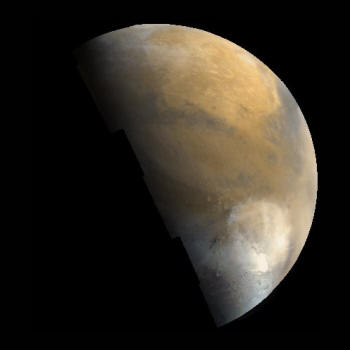
On the other hand, if the methane now being measured is liberated by
current life on Mars, then the relatively small amount observed
(something on the order of ~90,000 tons in the entire Martian
atmosphere), and the calculated rate of its replacement (as little
as
300 tons per year to maintain what is observed), definitely means
a “less than thriving present Martian biosphere.” Even this
observation fits perfectly into our own on-going,
“catastrophic
Mars” scenario:
The accumulating evidence that Mars -- sometime in the last ~100
millions years -- suffered an almost incomprehensible and global
cataclysm, leaving the Mars we know completely ravaged, its Southern
Hemisphere cratered “wall-to-wall” … and 99.99% of its former
biosphere obliterated ….
Because: it’s not an “either/or ….
Both scenarios could well be true.
Methane could be produced, today -- by some still surviving, still
struggling form of hardy Martian life form -- amazing organisms,
adapted to the current “devastated Mars” …
Augmented … by methane from yesterday’s “incomparably richer Mars” …
still leaking from an unimaginable planetary tomb.
But barring those critical carbon isotope determinations … how can
we estimate (at this point) the more probably scenario?
Recent spacecraft observations – particularly those made by the
European’s first Mars mission, Mars Express – may already have
provided vital clues ….
A few weeks ago, the German HRSC camera aboard Mars Express began
returning striking, full-color views of major regions of the planet.
One of the areas published on January 23, 2004 was Gusev Crater –
the regional Mars location of one of the two JPL rover missions
currently exploring Gusev’s ancient floor (dark area, right side of
the ellipse, below).
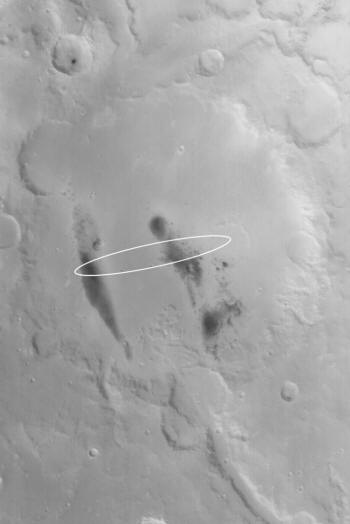
As noted earlier, Gusev -- the site of the current Spirit rover
mission -- just “happens” to be the site of one of our two former
tidal oceans ... as well as a region of
currently enhanced ground
ice along the Mars’ equator, as determined by the Mars Odyssey GRS
instrument.
What made the Mars Express Gusev image so immediately interesting
was the fact that those “dark markings” – the intricate features
seen streaking portions of the floor of the 90-mile-wide Crater in
the black and white imaging (above) -- in color (below) … were
revealed by Mars Express to be various amazing shades of green ….
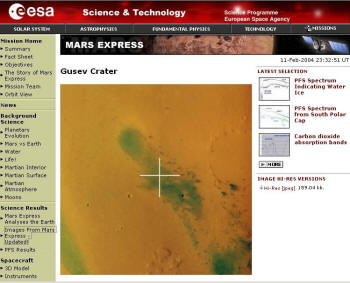
Reaction to this startling European Gusev image was immediate … and
highly controversial:
The blatant “green” indicated to many the distinct possibility of
current plant life on the floor of Gusev. Linda Moulton Howe managed
something of a scoop, when – shortly after the above Mars Express
image was published – she managed to get an
on-the-record statement
from Michael McKay, Flight Operations Director of the European Space
Agency:
“… like the green in the Gusev crater picture … it certainly gives
rise to the speculation that there could be algae [there] …. It
certainly gives much more weight to such speculation, particularly
since here on the Earth's glaciers and [in] the Alps and [at] the
North Pole, you can see algae in the ice itself which turns rather a
pink color or greeny-grey color. Just tying that observation on the
Earth together with things we are starting to see on Mars, certainly
adds a bit more weight and people will seriously be thinking about
these questions and trying to put some definite answers to them …
[emphasis added].
”Remarkably -- right after this extremely leading, extremely
provocative statement -- the color of the official Mars Express Gusev image on
the German Space Agency web site (below, lower right)
was curiously “recalibrated.”
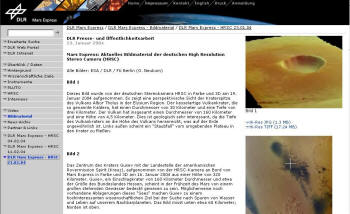
While, simultaneously, the caption on the official ESA site carrying
the Gusev “green” image was also altered (below) – with a key line
added: “Note the green coloring is an effect of image processing ….”
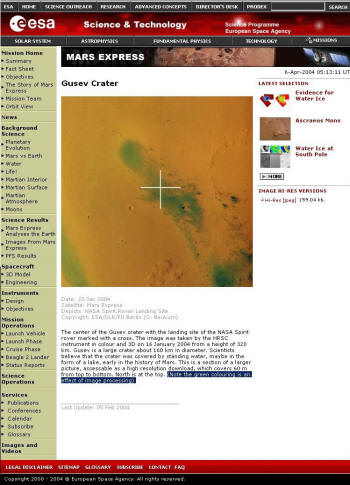
However, inexplicably …
the image on the site (as you can see) … remained
UNCHANGED! Which, given that a “recalibrated” version of this same
image had just replaced the original on the official German web
site, is completely baffling .… Unless..., it was a -- “Don’t’ pay attention to the caption … keep focus on the
image …” -- kind of thing.
Our reaction was a bit more direct.
Enterprise published, as a continuation of our previous discussion
of NASA’s apparent “inability” to “get the colors right,” a
side-by-side comparison of the provocative old/new Mars Express
image … and … a “colorized” comparison of the same Gusev region. The
latter was unofficially created from official NASA THEMIS data and
colorized (from the same data) by space artist and NASA contractor,
Don Davis (below).
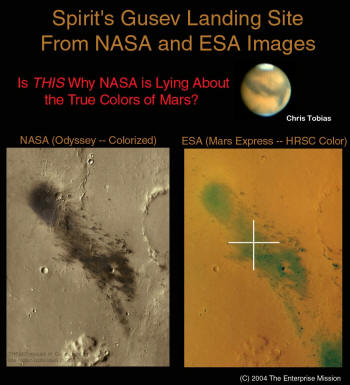
It was certainly obvious from this particular comparison, that
something indeed was/is very wrong with NASA’s Martian colors! As if
one needed such comparisons; as can be seen on JPL’s own web site
(below) three different color versions of the same Pathfinder
surface panorama, attest to “something” going on behind the scenes
in NASA ... regarding Mars’ true colors.
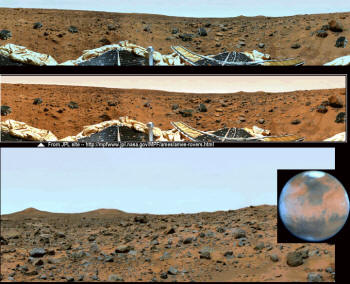
Now, even after the officially attempted “correction” on the German
web site, on enlargement of the revised Mars Express image (below,
right), the wispy streaks were still green – albeit a darker
“bluish-green” (with maybe some purple thrown in)! What was truly
fascinating was that, strikingly obvious in the new color image, the
streaks” emanated directly from the large and small dark crater
floors. This visible preference for the wisps to “somehow” want to
“interact” with craters was not easily explainable in terms of the
prevailing NASA model:

Which still maintains that the sinuous dark features on Gusev’s
floor are simply random wind streaks … caused by “lighter Martian
dust” being removed by local dust devils from the darker, underlying
surface.
In fact, the imaging comparison (above) revealed the opposite:
That the Martian winds are preferentially removing something “dark”
from the floors of the “even darker” craters … and depositing it on
the plains between these craters -- as the “wispy, blue-green,
purple streaks” so evident in the “recalibrated” German image
(above, right).
This is where two completely independent Mars observations suddenly
came together.
When Spirit landed on the floor of Gusev on January 3rd, one of its
first high-resolution surface color images (below, processed by
Keith Laney) showed a mysterious “patch of something” lying a few
feet from the lander. The nickname the rover Science Team eventually
gave this curious surface feature was “the Magic Carpet.”
Even
Stephen Squyres, Principal Investigator for
the Science Team, described it as,
“… bizarre, really weird" the way in which the crater floor seems to
have responded to the dragging of the rover's airbags, which
deflated after the lander bounced down onto the surface after being
released from its parachute. "I don't understand it," he said.
Surface pebbles seem to have been squished into the soil around the
lander, which appears like layers of cohesive material.
"It looks
like mud, but it can't be mud. It looks like when it is scrunched,
it folds up," said Squyres, who added, "This is something I have
never seen before …. [emphasis added]."
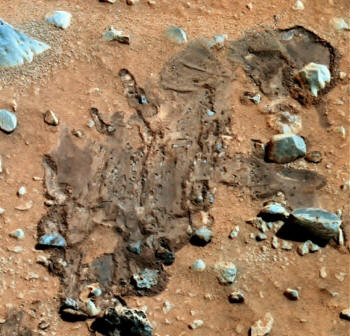
Notwithstanding Steven Squyres’ public fascination with this
remarkable “soil anomaly” – remember, the head of the rover Science
Team -- when Spirit descended from its lander a few days later,
instead of investigating the “Magic Carpet” close-up with its unique
array of instruments, the rover was instead commanded to drive as
fast as possible several hundred feet away … to “Bonneville Crater.”
The mystery of the Magic Carpet literally left behind … never to be
solved.
But … what if they’re connected?
What if … Mars Express’ new color image of the mysterious “dark
streaks” covering sections of the floor of Gusev Crater is somehow
“connected” to Spirit’s equally provocative observations on that
Crater floor … of the mysterious “Magic Carpet” area. Suppose, that
the Spirit images of a “mud-like surface feature” were exactly that
– images of Martian mud!? Suppose, that a highly concentrated brine
solution lies just under the surface rocks and dust … beneath major
sections of this ancient Crater floor!?
After all, this was supposed to be an “ancient crater lake” at one
time, wasn’t it?
Then, suppose that, since it was summer at the Gusev site when
Spirit landed, this subsurface brine solution had once again
seasonally melted … (surface Martian temperatures can be as high as
70 degrees F.) -- creating a layer of literal mud just beneath the
surface rocks and dust!
Spirit lands … the airbags drag across this partially wet, very
sticky surface, and -- viola! -- Spirit captures the first image of
a genuine “mud puddle” on the planet Mars!
So, what has this to do with the “greenish” color and sinuous nature
of the streaks -- and their obvious preference for craters …?
If the ”Magic Carpet” was indeed caused by a briny “water table”
lying beneath the ancient, dry lake Gusev surface, then every crater
in the area – having punched through this surface crust to varying
depths – should extend well below this dry and dusty surface … well
down into the “brine layer!”
On Earth, such a situation would be
tailor made for all varieties of simple (and even complex) plant
life to begin to grow – particularly, certain kinds of algae. Some
species of terrestrial algae are extremely adapted to
highly saline
conditions (below), and often reproduce by
creating spores, which
are then redistributed by local winds, forming other colonies.
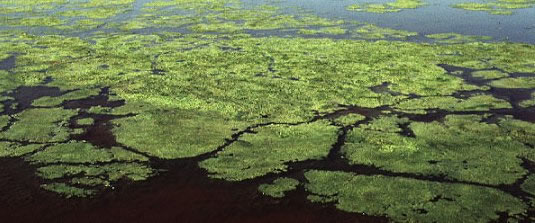
At Gusev, if the craters in the area were indeed harboring
conditions conducive to some special algae growth – primarily, by
extending below the local water table -- then one could easily
speculate that as the algae mats within some craters grow in the
Martian spring and summer, and ultimately reproduce, their spores
are carried by the winds out of the craters ... to form the long,
sinuous streaks across the intercrater surfaces observed from orbit!
The “streaks,” then, would simply be more colonies of algae from the
craters … spread by algae spores surviving for a time between the
crater floors ….
However, deprived of crucial quantities of water and essential
nutrients (which, in this scenario, would be concentrated on those
crater floors), the migrating algae colonies between the craters
quickly die … and decompose. Through this process, they would
inevitably release some of their bound organics – the hydrogen,
carbon, etc. -- back into the atmosphere … to be seen as significant
quantities of methane gas (below).
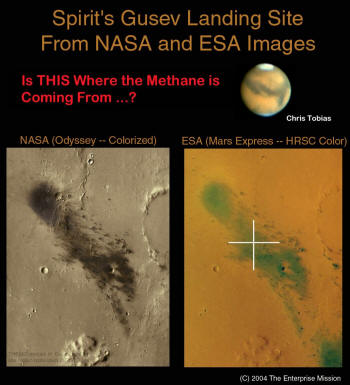
All of which fit neatly into Mumma’s now
observed concentrations of
this important biomarker over Gusev and Meridiani Planum – site of
our two salty (!), ancient tidal ocean floors.
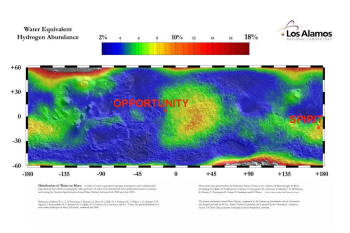
The fact that salty water would be lying below the current Gusev
crater floor, and is apparently still migrating upward toward the
surface through evaporation, should not be too surprising; not only
does this fit perfectly with our scenario – that, “only” 65 million
years ago this was once the site of one of Mars two major planetary
oceans – but the immediate soil analysis conducted by the Spirit
rover when it descended from the lander found anomalously high
concentrations of sulfur (S), sodium (Na) and chlorine (Cl) (x-ray
spectra below) … all well known evaporate deposits of former
salty
oceans.
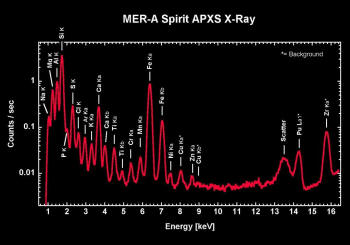
Which brings us back to the curious anticipation of all this by
George Pimental … in 1969.
According to
a new report, “1969 Mariner 7 IRS: Data Set Recovery
and Calibration” (Laurel E. Kirkland, Kenneth C. Herr, Paul B.
Forney, and Donald K. Stone):
“In 1969 the Mariner 7 Infrared Spectrometers (IRS) returned a
unique set of approximately 140 infrared spectra of the planet Mars
covering the wavelength region from 1.8 to 14.4 µm (5550 – 690
cm-1). Meanwhile a third IRS was actively measuring lab spectra of
gases, minerals and ices thought to be present on the ‘Red Planet.’
Unfortunately, over the following three decades, all the IRS in
flight calibration data, much of the preflight calibration data, and
all of the IRS lab data were lost to the planetary science
community.
“The IRS spectra contain a wealth of information, but in many ways
the data set remains an untouched resource. In main this is because
the IRS spectra of Mars were never released in a version calibrated
in wavelength and intensity, and because the lab spectra were never
released at all. Also, computers have improved to the point that it
is now practical to manipulate the data more extensively. Therefore,
we desired to recover and calibrate this unique data set.
“We located the original IRS data tapes, recovered the spectra
measured of Mars, collected instrument and calibration information
from the original IRS team, and proceeded with the calibration
[Forney and Kirkland,1997; Kirkland et al., 1998]. Thus for the
first time since the 1970's, we have IRS spectra that are calibrated
in wavelength and intensity using the original data set and
calibration information and expertise from the original IRS team …
[emphasis added].”
Unfortunately, at this writing, the only portion of the ‘69 IRS
Mars’ data fully recovered and recalibrated is the long-wave
section. The short wave data --including those highly controversial
lines originally attributed to methane and ammonia -- remain
unreexamined ….
What’s remarkable about this story is that, with this crucial
calibration data mysteriously missing for over 30 years, no
meaningful outside analysis was ever carried out on Pimental’s
original Mars spectra, by any other agency or scientist. Thus, what
it was that Mariner 7 really saw as it crossed the “dark collar” of
the southern Martian pole – especially in light of the three
independent teams’ recent, startling “rediscovery” of methane in
that atmosphere – remains a 30-year-old mystery ….
Two important additional developments that may have bearing on this
mystery have come in recent years. Mars Surveyor has returned
striking images since 1997, not only
thought by some to represent
seasonal growth and decay of large colonies of living microorganisms
near the south pole (below, top), other MGS images have been
interpreted as revealing even more astonishing biological forms
(especially in the view of certain observers, such as
Arthur C.
Clarke) – entire fields of trees… or bushes … near the southern pole
(below, bottom).
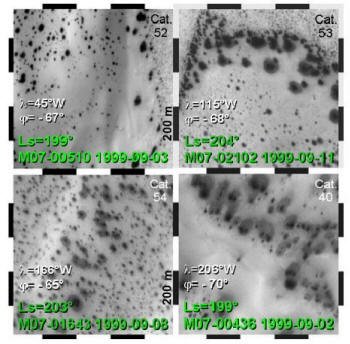

Significantly, when Mariner 7 flew by Mars on August 4, 1969, it was
the beginning of Martian Spring in the southern hemisphere …
precisely when these mysterious dark “spots” are first seen to form
around the polar cap …. Is it unreasonable, if these are real
microbial colonies, to speculate that they would be giving off
significant methane and ammonia during the Mariner ’69 flyby …?
Looking again at the IRS Mars spectrum in comparison with an actual
methane calibration spectra (below), one is left to wonder –
regardless of his later “recantation,” and curiously “missing”
laboratory data to support his reversed views -- if the real
“methane on Mars” story didn’t in fact begin with George Pimental …
over 30 years ago.
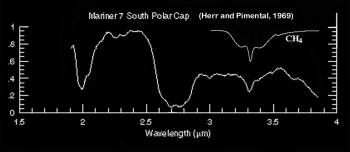
In fact, the complicated story of “hydrocarbon molecules on Mars” –
and thus, indirect confirmation of current Martian life forms --
began much earlier ….
In 1956, an astronomer, pioneering infrared studies of solar system
objects,
William H. Sinton, carried out perhaps the earliest IR
Martian survey. Sinton published a preliminary finding of “three
absorption bands … likely due to C-H bonds … concentrated over the
major dark markings of the planet.” These hydrocarbon bonds he
attributed to chlorophyll – the major photo reactive molecule in
planet life. Along with “chlorophyll,” Sinton also recorded a
suspicious feature near 3.3 microns (below), indicative of …
methane.
Later, Sinton (like Pimental years later) would recant his own
Martian observations. But, curiously, despite constantly improving
technology, there was never any follow up ….
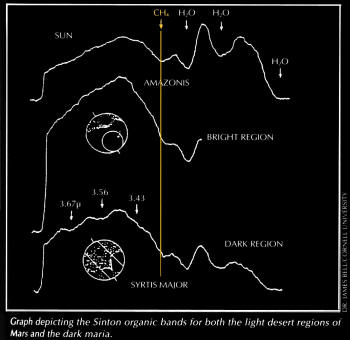
Part 3
Until..., four decades later, another astronomer -- Dr.
Serguei Mikhailovich
Pershin -- carried out a different search for chlorophyll on Mars.
This technique utilized the major quantum leap (over 1950’s IR
technology) represented by the Hubble. This is how we described
Pershin’s still unnoticed -- but now extremely relevant work (in
light of the “new” methane discoveries) -- in
an earlier Enterprise
paper:

“Pershin is a Russian space scientist, who, in 1985, developed a
space borne, remote-sensing laser experiment for the 1988 Russian Phobos Mission. In 1996, another of his experiments – a compact
aerosol backscattering lidar ("light detection and ranging" laser
instrument), capable of measuring the composition of the Martian
atmosphere from a balloon or landed spacecraft – won a competition
for inclusion by NASA on the ill-fated 1999 Mars Polar Lander
Mission. (Pershin’s instrument was the first and only experiment
from Russia to be flown on a United States Mars mission.)
“In 1998, Pershin – utilizing narrow-band images taken with the
Hubble Telescope, and computer-processing them as multi-spectral
band ratios – initiated the first follow-up to Sinton’s
controversial observations in forty years … announcing that he’d
discovered strong indications of red chlorophyll pigment
fluorescence (induced by ultraviolet solar energy) from
certain
regions of the planet. These curiously enhanced regions (below, far
right) were similar to narrow-band enhancements he’d detected in his
laboratory laser experiments, using UV lasers as remote sensing
tools to excite the chlorophyll emissions from a variety of
terrestrial soil samples.

“Pershin’s conclusions, even as a Russian scientist, only loosely
associated with NASA, were carefully "politic": that he’d discovered
only "relic organic pigments… from potentially former living
organisms ….", but not evidence of current Martian life. In truth,
raw ultraviolet light reaching the Martian surface would quickly
destroy any exposed [truly ancient] "fossil chlorophyll." So, if Pershin’s results are valid, they have to be produced by living
organisms!”
Well, almost living ….
In fact, after further calculation, even when a chlorophyll-bearing
plant died on Mars (assuming in this scenario such organisms exist),
there would ensue an uncertain period of time -- years, perhaps even
decades -- when that chlorophyll would remain essentially intact;
even raw solar ultraviolet light would take significant time to
eradicate all traces of the molecule – especially, if evolution in a
higher UV background (Mars?) had incorporated additional molecules
around the chlorophyll, to precisely
inhibit such destructive
radiation to a living plant.
Thus..., if the “fossil Martian chlorophyll” Pershin conclusively detected
just six years ago from Hubble, was indeed from “former living
organisms” -- perhaps from living plant life dead only a
comparatively brief period – then the Russian astronomer could
easily have measured some surviving “relic chlorophyll” … still
unaltered, and localized in the classic “dark regions” (once the
most densely living) of the planet.
But, how could this be possible? How could vast stretches of once
living vegetation, on an entire planet, so rapidly die off … that --
just before the coming of the “space age” -- Mars had literally
“died!?”
The answer is: in this scenario, it didn’t “die” -- but just went
into a cyclic “seasonal suspended animation” … until a new “coming
Martian Spring” ….
One of the increasingly enigmatic Martian observations, made by the
unprecedented “fleet” of unmanned spacecraft currently sending back
extraordinary data, is compelling news that -- before our eyes –
Mars has changed … is changing. The evidence is most compelling:
multiple images – from Viking, Mars Odyssey and Mars Surveyor – all
showing unmistakable signs of major climate change … now occurring
across Mars.
The examples range from, side-by-side comparisons of literal melting
(and disappearance) of key features at
the Martian poles between 1999 and 2001
(below),
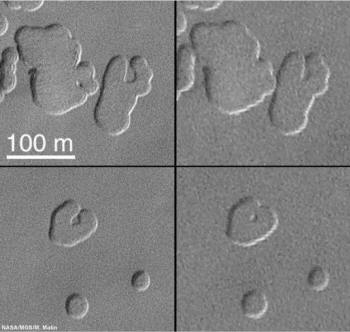
-- to, increasing evidence that the ground ice in certain equatorial
regions we first predicted -- based on
our Mars Tidal Model -- is
also melting … creating dark and mysterious surface features we
believe are intimately connected, which
we originally discovered in
2000 (below), now called “stains” or “seeps.” Originally dismissed
by NASA scientists as merely “avalanches,” recent scientific journal
papers on these features have finally admitted possible involvement
of liquid water, and reported significant new developments:

The number of “stains” (officially called “streaks”) imaged by the
two currently operating NASA orbital spacecraft over Mars is rapidly
increasing – and, at an accelerating rate! According to the authors
of
one paper:
“… either there is a complete turnover within a few decades or the
streak population is currently increasing rapidly. Large spatial, as
well as possible temporal, variations in the formation rate are
obtained from these data. Streaks do not appear to fade over time
periods comparable to their inverse formation rate of ~28 years, as
seen by analysis of Viking Orbiter images containing streaks that
are still visible in MOC images [emphasis added].
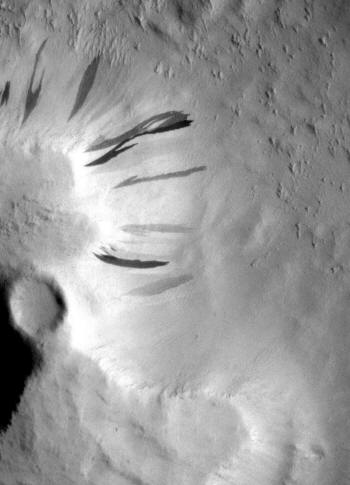
In other words ….
Mars is melting!!
Mainstream models notwithstanding -- which predicate prior episodes
of global climate warming based on calculated changing obliquity
shifts (axis tilts) of Mars -- there is no current shift in the spin
axis of the plane! Thus, there is no scientific explanation in the
mainstream NASA view to account for an obvious and global “global
warming” currently taking place on Mars. There is, however, our own
Hyperdimensional Energy Model – which predicts precisely what we’re
seeing in the NASA images ….
In 2002 we wrote a short paper – “Global Warming on Mars?
- The Hyperdimensional Connection” -- summarizing a range of these
examples. While some may argue with specific images, the consensus
even among mainstream planetary scientists looking at the data
coming down from Mars Odyssey and Mars Surveyor is that Mars – for
unknown reasons – is definitely warming up.
Some examples, presented side-by-side with equivalent satellite
imaging from Earth, are simply striking: such as this comparison
(below) -- between the famous “Great Salt Lake” in Utah and an
eerily similar, very liquid-looking and deepening Mars “Lake Laney”
(so named by us, because Keith did the image processing of the
original Odyssey color data). For those who still believe (ala the
earlier Mariner fly-bys) that large bodies of liquid, standing water
on Mars are currently impossible, we simply refer you to
recently
published laboratory work indicating just the opposite!
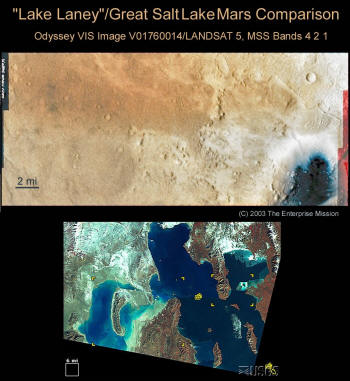
Finally, the imaging OMEGA spectrometer on Mars Express (below)
revealed a surprising (and apparently significantly larger) quantity
of water ice at the Martian southern pole -- far more than previous
missions, going back to Mariner 69, had indicated. If the planet is
indeed warming, and on a timescale of only decades, this would be
one of the earliest indicators … as the water released via
increasing ground temperatures melting the ground ice from the two
former equatorial oceans in summer, in the winter would migrate to
the poles and fall as ordinary snow, thus increasing the observable
water ice on the surface of the polar ice caps.
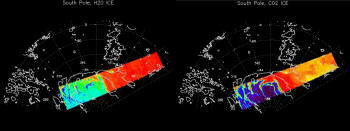
So, what does this all mean?
If the current methane observations are indeed evidence of living
Martian organisms, it is more than likely that they are the
surviving remains of a once flourishing, far more complex Martian
ecosystem. But, even if the methane is not from living microbes now
-- as
has been noted previously, the source is more than likely due
to venting of long-buried methane pockets, created by that same
extensive Martian biosphere … before whatever catastrophe ensued ….
Either way, in the Tidal Model, the now confirmed
“rediscovery” of methane opens the door to unprecedented
possibilities for an entire “living Mars” … including - that Mars could once have been a home … to
ancient “Martians.”
If Mars is significantly warming -- as the various independent
lines
of accumulating evidence seem strongly to confirm -- it is on an
impossibly short time scale according to any current NASA
calculation. It is therefore at least a possibility that these
observed changes are due to the larger, solar-system-wide, Hyperdimensional Physics we’ve previously identified … that is also
definitely changing (we shall be publishing an entire, more
definitive paper on this important development in the near future).
All this means that another “Martian Spring” – for whatever life
forms are remaining – could be coming ….
It means that the “distinct and repeating Martian seasons” … the
annual “waves of darkening, emanating alternately from each pole”
... and the “dark areas turning an unmistakable blue-green each
Martian spring” -- all observed and carefully recorded by
the giants
of 19th century astronomy, Schiaparelli, Lowell,
Antoniadi and the
rest -- are possibly returning ….
Including..., the startling possibility that the most well known marker of this
19th Century Mars -- its infamous “canals” -- may also have been
real all along ….
This is how Lowell described them in 1908, in "Mars, As The Abode of
Life":
"There are celestial sights more dazzling, spectacles that inspire
more awe, but to the thoughtful observer who is privileged to see
them well, there is nothing in the sky so profoundly impressive as
these canals of Mars. Fine lines and little gossamer filaments only, cobwebbing the face of the Martian disc, but threads to draw one’s
mind after them across the millions of miles of intervening void …”
It now seems possible, because of this “coming Martian Spring,” that
even that most mysterious of all the Martian puzzles recorded just
decades ago – which seemed to completely vanish once the Space Age
dawned, much to the derision of Lowell and the other 19th Century
astronomers who saw them -- may also become visible … again.
In the summer of 2000, immediately following a “major NASA briefing”
detailing evidence of
recent water flows in some areas of Mars, we
proposed
a striking alternative explanation: that the curious
features indicated by the NASA team were, in fact, caused by nothing
less than “surface leaks from the deterioration and decay of a vast,
underground, artificial water transport system.” In part we said:
“… if you have pipes, and you run water through them, what happens
when the temperature gets too low?
“The pipes burst!
“This is why the water is being found in the cold regions pointing
away from the sun. Because a system designed for use in a much
warmer epoch (maybe only tens of thousands of years ago) is failing
when the temperature causes the pipes to expand and burst. This is
why the water is being found out of the sun and toward the poles!
Because the sun is keeping the water in a liquid, flowing state
closer to the equator.
“The implications of this are vast. So are the stakes ….”
Less than a month later,
we discovered our first “seep”
-- apparent
liquid water … leaking from “some source underground.”
Only a few days before that, we had made perhaps our most
significant technological discovery on Mars since the Face itself: a
huge, obvious
underground glass tunnel – partially unearthed
(below). Its scale alone – almost a thousand feet wide, and several
miles in length – was a major clue that this might in fact be a
component of nothing less than Lowell ’s ancient irrigation system
of “canals” ….
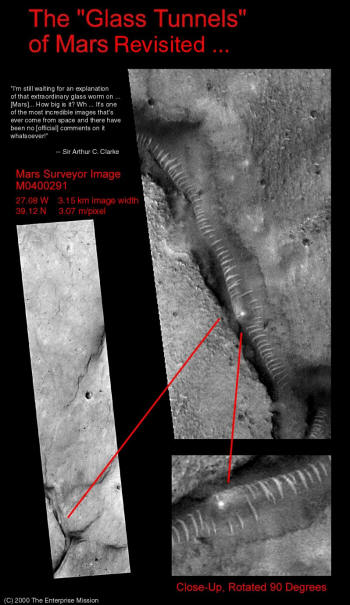
In other regions, several “glass tunnels” (and their associated
geometric infrastructure) seem to parallel each other – after also
being partially unearthed (below).
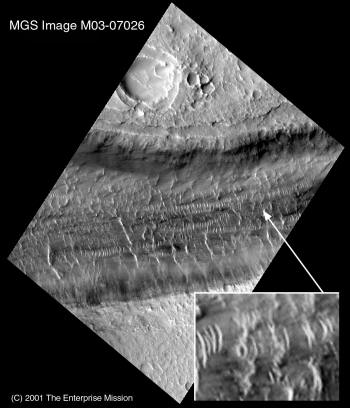
Here, in the “grandest canyon” in the solar system –
Vallis
Marineris – another partially exhumed tunnel can be seen (below) --
branching in a familiar “Y” at the joining of two previously
separated sections (below, left)

Putting all these “dots” together:
It now seems quite possible that what we discovered in the summer of
2000 – from clear evidence of leaking water, to the multiple
examples of the obvious means of transporting enormous quantities of
that water across great Martian distances … underground – could
finally explain this most lingering of mysteries about the Red
Planet: its infamous network of canals.
But how, you might appropriately ask, could an ancient underground
engineering system create visible features on the surface –
ostensibly seen (and drawn) by 19th Century astronomers? How indeed
….
If the Martian climate can indeed undergo drastic cyclic variations,
and on a timescale of mere decades, there is the distinct
possibility that these mysterious surface features are also part of
such a living cycle. That these enigmatic “linear formations” are
recreated each Martian “spring” by living surface vegetation …
growing directly over the massive, buried planetary network of an
“ancient, now leaking, high-tech water transport system” – composed
of our glass tunnels.
In the March, 2004 issue of Sky & Telescope magazine, Thomas Dobbins
and William Sheehan present a fascinating new case for some of the
classical “Lowellian canals” seemingly returning … their being
objectively recorded during the 2003 Closest Approach -- by the
unprecedented CCD and webcam electronic imaging technology now
available to amateur astronomers world wide. As can be seen (below),
a comparison of one of Lowell ’s old planetary charts from 1895 and
a modern webcam image from 2003, reveal an amazing degree of
commonality ... for a supposed “figment” of Lowell ’s imagination!
[Elsewhere, Eric Lausch (under the nome de plume of “Johnny Danger”)
has written a thoughtful, highly cogent and extensive analysis
titled “Lowell’s Legacy,” on just what our ancient, buried tunnel
network, in the coming “Martian Spring,” might mean. I strongly
recommend it, in the present context ….]
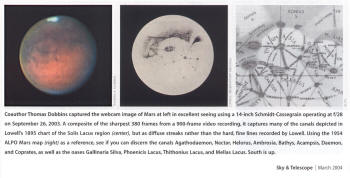
These exciting possibilities -- with strong hints of many more to
come (remember: Mars Express carries
the MARSIS radar, which can
detect not only underground pools of liquid water 3 miles below the
surface … but surface pools as well) -- create a totally
revolutionary context for the “new” methane observations of the last
few days ... that “Martian Spring” may indeed have come again.
And, if Spring is coming … in light of the earlier Mariner ’69
foreshadowing, in light of the President’s recent annunciation of a
“grander vision” for humanity itself -- can a similar season of
“renewal and reawakening” in Washington be far behind … concerning
other “Martian revelations” …?

|











































